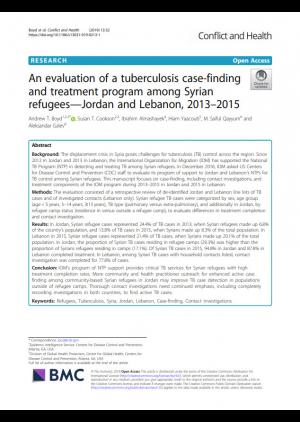Abstract
Background: The displacement crisis in Syria poses challenges for tuberculosis (TB) control across the region. Since 2012 in Jordan and 2013 in Lebanon, the International Organization for Migration (IOM) has supported the National TB Program (NTP) in detecting and treating TB among Syrian refugees. In December 2016, IOM asked US Centers for Disease Control and Prevention (CDC) staff to evaluate its program of support to Jordan and Lebanon’s NTPs for TB control among Syrian refugees. This manuscript focuses on case-finding, including contact investigations, and treatment components of the IOM program during 2013–2015 in Jordan and 2015 in Lebanon.
Methods: The evaluation consisted of a retrospective review of de-identified Jordan and Lebanon line lists of TB cases and of investigated contacts (Lebanon only). Syrian refugee TB cases were categorized by sex, age group (age < 5 years, 5–14 years, ≥15 years), TB type (pulmonary versus extra-pulmonary), and additionally in Jordan, by
refugee camp status (residence in versus outside a refugee camp), to evaluate differences in treatment completion and contact investigation.
Results: In Jordan, Syrian refugee cases represented 24.4% of TB cases in 2013, when Syrian refugees made up 6.8% of the country’s population, and 13.8% of TB cases in 2015, when Syrians made up 8.3% of the total population. In Lebanon in 2015, Syrian refugee cases represented 21.4% of TB cases, when Syrians made up 20.1% of the total population. In Jordan, the proportion of Syrian TB cases residing in refugee camps (29.3%) was higher than the proportion of Syrians refugees residing in camps (17.1%). Of Syrian TB cases in 2015, 94.8% in Jordan and 87.8% in Lebanon completed treatment. In Lebanon, among Syrian TB cases with household contacts listed, contact
investigation was completed for 77.8% of cases.
Conclusion: IOM’s program of NTP support provides critical TB services for Syrian refugees with high treatment completion rates. More community and health practitioner outreach for enhanced active case finding among community-based Syrian refugees in Jordan may improve TB case detection in populations outside of refugee camps. Thorough contact investigations need continued emphasis, including completely recording investigations in both countries, to find active TB cases.
